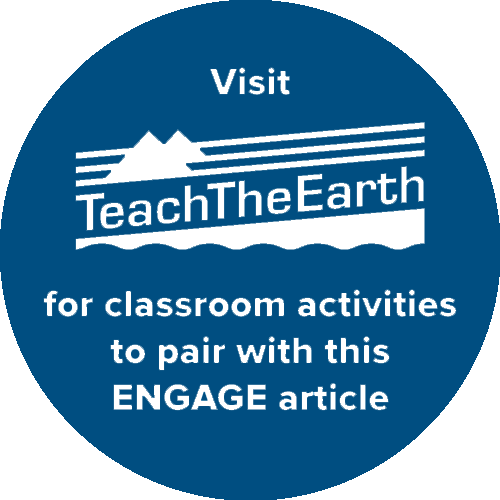A translation of this article was made possible by a partnership with Planeteando. Una traducción de este artículo fue posible gracias a una asociación con Planeteando.
People in every corner of the United States are increasingly seeing climate change affect their daily lives: water shortages and lost crops from extended drought, record-breaking heat waves in cities, hazy air from wildfire smoke half a country away, and hurricane-related flooding in basement apartments, to name just a few. However, not every extreme weather event convinces people that they are personally experiencing climate change. A recent study in Global Environmental Change has found that regardless of political and sociodemographic factors, experiencing an anomalously high number of hot, dry days is most likely to make U.S. residents believe they’ve experienced global warming.
“Climate change expresses itself very differently in different places—wildfires and drought in the West, hurricanes and flooding in the East, all of the above in Texas!” said Jennifer Marlon, a climate scientist at the Yale School of the Environment in New Haven, Conn., and lead author of the study. “This study points to the importance of helping people interpret local impacts from extreme weather and connecting those impacts to their root cause: fossil fuel burning and the carbon pollution it produces.”
A Dry Heat Is Convincing
In a national survey conducted from 2008 to 2015, more than 13,600 people responded to the question, “How strongly do you agree with the following statement: I have personally experienced the effects of global warming?” The researchers collected geographic, sociodemographic, and political information from the respondents and used those data to ensure that the responses came from a representative sample of U.S. adults. On the basis of the location of each respondent, the researchers then matched high-resolution climate data to responses to discover what climate impacts each person had experienced in the 12 months prior to completing the survey.
Hot, dry anomalies increased perceived experience with global warming across political lines.
“People who do not believe that global warming is real or a threat can experience extreme or unusual weather and deny that it has anything to do with human activities or climate change,” Marlon explained. This generalization mostly held true in the new study. After heavy or very heavy rain, heavy snow, and unusually hot (but not dry) days and seasons, respondents were no more likely to believe they’d experienced global warming than they had before. Only after experiencing an unusually high number of hot, dry days were respondents more likely than the national average of 30% to answer that they had personally experienced global warming. Each year of the survey, the shift in perception was greatest in regions that were most affected by heat waves and long-term drought, including California, Texas, and cities across the country.
What’s more, these trends held true regardless of respondents’ political party affiliation (Democrat, Independent, Republican) and political ideology (liberal, moderate, conservative), two factors that often affect whether a person attributes an extreme weather event to climate change. Hot, dry anomalies increased perceived experience with global warming across political lines.

The researchers speculated that hot, dry days are more likely to affect people’s perception because the effects are much broader than those from other climate events. Hot, dry anomalies can last for months or years; can affect the agriculture, energy, water supply, recreation, and tourism sectors; and can generate national-level economic losses that exceed those of flood events.
The Challenge for Communicators
Richard Alley, a climate scientist at Pennsylvania State University in University Park who was not involved with the research, called the study “fascinating” and said, “Intuitively, the results make sense to me….[The phrase] ‘global warming’ has been used extensively for decades to describe the human influence on climate, causing many people to associate warming with human influence. Almost everyone knows that a clothes dryer or hair dryer works faster when the heat is on, so the association between heat and drought is expected.”
“Communication needs to be tailored geographically.”
“The direct relation between, say, flash floods and human influence on climate, or price inflation linked in part to crop failures and supply chain disruptions linked to human-induced climate change, is less obvious but no less real,” he continued. “Their results are important for all of us who communicate about climate, which increasingly is all of us….The challenge for communicators is made clearer.”
This study highlights that “communication needs to be tailored geographically so that people can see which health impacts, infrastructure, and neighborhoods are most at risk in their own communities,” Marlon said. “People also need to know where new opportunities exist for effective mitigation, adaptation, and innovation.”
Because this survey was conducted until only 2015, it did not capture any changes in perception following Hurricanes Harvey, Irma, and Maria in 2017; the devastating 2018 and 2020 wildfire seasons in California; the costly and deadly winter storm in Texas in February of this year; or other more recent climate-induced extreme weather events. “The survey is ongoing, and we are continuing to study evolving perceptions,” Marlon said. “As weather continues to worsen, these events seem to be persuading at least those who already see climate change as a threat—which is most of the country now—to take it even more seriously and to motivate more aggressive action.”
—Kimberly M. S. Cartier (@AstroKimCartier), Staff Writer
This news article is included in our ENGAGE resource for educators seeking science news for their classroom lessons. Browse all ENGAGE articles, and share with your fellow educators how you integrated the article into an activity in the comments section below.


